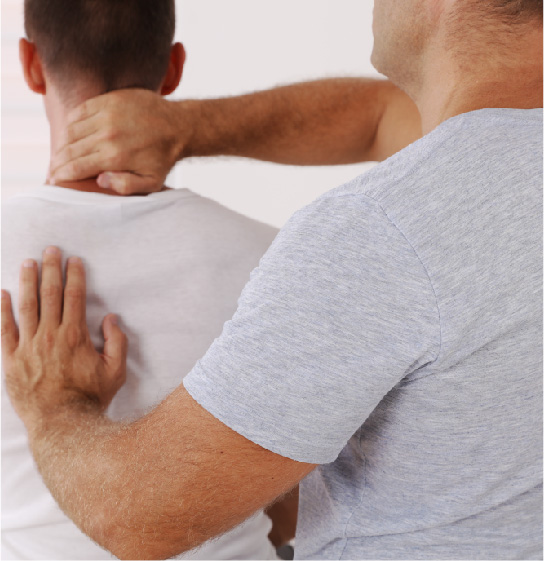Nerve Root Irritation
What kinds of conditions affect nerves?
Nerve root irritation is often referred to as a “pinched nerve”. “Compressed nerve” would be technically more correct. This includes conditions like Sciatica, where the site of the pain does not necessarily reflect the site of the injury.
What happens to the body?
Nerve root irritation may occur as a result of the nerve being compressed, or the nerve root irritation may lead to nerve compression. Nerve compression may originate from a number of different sources. A common cause of nerve root compression is inflammation of the nerve, which causes an enlargement of the nerve root as it exits the spinal column. Another common cause may be a bulging or prolapsed disc. This condition is more common in the lumbar (lower back) area, and may affect the sciatic or femoral nerves. The third of the common causes is age or trauma related degeneration, which may affect the disc height, or may lead to new bone growth, called osteophytes, which may compress the nerve root.
What to do and what not to do?
- Avoid aggravating the condition. Stretching is not always the best way to deal with nerve root irritation. It can often aggravate the nerves, putting them on stretch and causing the muscles to contract around the area, similar to a neural tensioning injury. This can increase pain and restrict movement further.
- Gentle stretching can help. If you’re going to stretch, keep the stretches gentle and pain free. This can help to relax the muscles, and may help to reduce some of the pressure that may be irritated the nerve root.

Neural Tensioning
What kinds of conditions affect nerves?
Neural tensioning is an injury found in much of the population. It can present anywhere from mild to severe symptoms, and is often interpreted as “tight muscles”. In more severe cases, it can cause pain and loss of function due to restriction of range of motion.
What happens to the body?
With this condition, the nerve becomes stuck within its sheath, meaning that when a sufferer attempts to move, the movement causes a stretching of the nerve, rather than the usual smooth gliding action. This may occur as a protective mechanism, where the muscles contract around the nerve to prevent excessive movement after an injury.
What to do and what not to do?
- As for nerve root irritation, gentle stretching, rather than strong stretches, can help to relieve some symptoms. It is very important that you don’t stretch into pain.

Central Sensitisation
What kinds of conditions affect nerves?
Central sensitisation usually occurs as the result of a chronic injury, rather than being an injury in itself. However, central sensitisation can lead to severe loss of function and reduction in quality of life, if left untreated. This condition includes things like allodynia (the experience of pain from a stimulus that should not cause pain) and hyperalgesia (an increased sensation of pain).
What happens to the body?
With this condition, the nerve becomes stuck within its sheath, meaning that when a sufferer attempts to move, the movement causes a stretching of the nerve, rather than the usual smooth gliding action. This may occur as a protective mechanism, where the muscles contract around the nerve to prevent excessive movement after an injury.
What to do and what not to do?
- As central sensitisation can result in unusually low pain thresholds, it can be beneficial to provide yourself with gentle, controlled contact in the sensitised area. This can be useful in training the brain to better deal with those touch sensations. Things like stroking the skin can be useful for this purpose. You can try using a variety of tools, such as fingers, tissues or paintbrushes to stimulate different sensations.

Peripheral Neuropathy
What kinds of conditions affect nerves?
Peripheral neuropathy refers to any condition where peripheral nerves become damaged or diseased. Diabetes is a common cause of peripheral neuropathy, but there are many others. The peripheral nerves supply everything outside of the central nervous system (the brain, brainstem and spinal cord), including almost everything in your torso, arms and legs. Symptoms may include numbness, pins and needles or burning sensations, weakness and pain.
What happens to the body?
Peripheral neuropathy may result from trauma, disease, infections, exposure to toxins, metabolic problems and inherited conditions. As such, the underlying mechanism could be any of a number of things. Essentially, though, the result is changes in the way that sensation is relayed to the central nervous system. The most common result is numbness or pain in the hands or feet.
What to do and what not to do?
- Check your extremities! An unfortunate side effect of losing feeling in your feet is that you may not notice wounds. These can become infected if not treated properly, which can lead to gangrene and loss of limbs. Make sure you regularly check you feet. Good foot care is essential.

Demyelinating Nerve Diseases
What kinds of conditions affect nerves?
Demyelinating nerve diseases attack the myelin sheath around the nerve. The myelin sheath is what allows information to travel quickly through the nerves, so that the body can respond to input, whether from the outside world or the brain. As the myelin sheath is broken down by the disease, this slows the potential speeds that the nerves can achieve, and therefore delays the information. In more serious cases, this can cause a complete disruption of the nerve, and no information can pass through the nerve. This can lead to complete loss of sensation, and complete loss of function.
What happens to the body?
For many types of demyelinating nerve diseases, it’s important to maintain as much function as possible. Keep moving; keep trying to participate in activities of daily living. You physiotherapist can help to give you exercises that will keep you strong, and strategies that can help you continue to be functional and independent.
What to do and what not to do?
- For many types of demyelinating nerve diseases, it’s important to maintain as much function as possible. Keep moving; keep trying to participate in activities of daily living. You physiotherapist can help to give you exercises that will keep you strong, and strategies that can help you continue to be functional and independent.

Spinal Cord Injury
What kinds of conditions affect nerves?
Spinal cord injuries vary in intensity based on where in the spinal cord the damage occurs (closer to the brain leads to worse outcomes), and how much damage is actually done (partial tear or complete rupture/severing of the cord). In many cases, damage to the spinal cord above the C4 vertebrae will be fatal, as this may affect breathing. Below C4, it is likely that the patient will suffer from some sort of neurological impairment, such as numbness, weakness, paralysis, and may even have trouble with automated bodily functions, such as the digestive system.
What happens to the body?
As for demyelinating nerve diseases, the important part is to continue doing what you are capable of doing. Your physiotherapist can help you with strategies to make daily tasks easier, and start to rebuild motor function, coordination and independence if that is possible.
What to do and what not to do?
- As for demyelinating nerve diseases, the important part is to continue doing what you are capable of doing. Your physiotherapist can help you with strategies to make daily tasks easier, and start to rebuild motor function, coordination and independence if that is possible.

Traumatic Brain Injury
What kinds of conditions affect nerves?
Similar to spinal cord injury, this diagnosis is usually given to describe a high impact injury to the head that affects the brain. Immediate symptoms may include concussion, confusion, difficulty concentrating and blurry vision. Long term symptoms may affect cognitive abilities, behavioural or mood changes, changes in vision, movement patterns or ability to move, speech difficulties and many other symptoms.
What happens to the body?
This injury occurs as a result of some sort of external force. Sporting injuries, car accidents, falls and assaults are some possible sources that could result in traumatic brain injury. Concussion and loss of consciousness (if due to trauma) are both considered being forms of traumatic brain injury. The symptoms may present immediately, or may take several years to present. The physical changes that occur as a result of these injuries are varied, and can be mild-severe-life threatening. If you suspect a traumatic brain injury, it is essential that you visit the emergency room of your local hospital. Once the immediate threat is dealt with, the patient may experience confusion, loss of function, loss of speech and motor control and a whole host of other symptoms. Many of these symptoms can be rehabilitated by your physiotherapist.

How do I know I suffer from a neural injury or condition?
For traumatic injuries, particularly affecting the head, neck or spine, it is essential that you visit the emergency room. If you are cleared, or this is an injury that has been present for some time, or this is not a traumatic injury, the best method for diagnosing this condition is a physical assessment, which all Musculoskeletal Physiotherapy Australia Clinicians are highly skilled at performing. During the physical assessment, your physiotherapist may assess coordination, reflex, neural tensioning, and sensation among other things. If your clinician believes that you have suffered from a nervous system related condition, they can recommend different types of treatment that will be suitable for your condition.



